In March, a new generation of programmable controllers from the Tecomat family saw the light of day at the Amper 2019 exhibition. A new star of automation has emerged for the coming decade. It has been the eleventh generation in a number of programmable controllers from Kolín since 1976. And there's a second name in Foxtrot. Why does it differ from its predecessor only in number? In its twelve years of existence and almost forty thousand installations around the world, Foxtrot has become a concept, a standard, but above all a proven automation tool with an architecture that has a great perspective in the future as well. It has only reached the stage where it is necessary to move it further in terms of performance. Although professional and media circles today push the number 4.0 into every concept as a sign of the fourth industrial revolution once proclaimed by the German government, we soberly add to Foxtrot only the number 2 as a designation for its second generation. Foxtrot 2 is an ideal standardized building block for solving tasks in the areas of Industry 4.0, the Internet of Things and all those SmartHouse, Smart Cities and especially Smart Grids.
The new Foxtrot 2 brings an elegant solution to the problems of the new era, which are faced by electricians, system integrators, designers and programmers. They are faced with the need to communicate both with slave devices and over the Internet, and moreover securely.
The number of types of interconnected devices, such as voice control, is growing, as is the number of types from different manufacturers. The number of used protocols is increasing and other new ones are still being introduced and standardized, IT and telecommunications technologies are penetrating into electrical installations with all the vehemence.
The basic modules of the new series start with the CP-2000 number and there are a total of five variants in the first wave. The basic feature of the new generation is full compatibility of application programs with the current first generation of Foxtrot and full compatibility with all existing expansion modules on the TCL2 and CIB Common Installation Bus®. The new features are quickly and concisely characterized as follows:
– completely redesigned and optimized firmware architecture
a new processor platform and operating system with the potential to scale performance by multi-core processors
-
two ethernet adapters
-
by adding two USB ports
new spatially reduced sub-modules with optional communication interfaces
-
four-line text display and 7 keys on all variants
-
variants with built-in WiFi adapter
-
variants with built-in LTE modem for direct connection to wireless internet
basic data storage of 128 MByte with a journaling file system is implemented on the motherboard, micro SD card is optional as additional storage
-
by increasing the number of variables on one web page
-
the speed of processing PLC instructions has increased tenfold
-
the memory for the application program is now 1MB, so it has increased three to five times
-
new system websites
-
strengthening cybersecurity by extending the set of IP protocols to secure ones, especially https
-
full compatibility with the Teco Route communication service
-
IoT protocols MQTT, REST API
-
the ability to access the file system in the PLC as a network drive
-
in the firmware integrated services PLCComS, Avahi, Samba, FTP
And now in more detail to the individual news. Let's start with the ones that are visible.
CP-2090; The smallest Foxtrot 2 has a half size
The CP-2090 version is "brushed off" its integrated inputs and outputs, and so the reduction of the new central unit in half is used. The resulting module on the DIN rail thus occupies only three modules and becomes the smallest PLC in this category. It can become a compact universal communication node directly equipped with up to four serial and two Ethernet ports, but it can also be the headquarters of a modularly built PLC, because it has masters of both expansion system buses. Both fast TCL2 and the installation one - CIB Common Installation Bus®. This miniature is, among other things, the manufacturer's answer to the requirements of multiplying installations, where Foxtrot is used mainly for its excellent and universal programmability of communication channels. It thus becomes a programmable converter of communications of various devices and protocols where direct inputs and outputs are not needed..
The new thing we find on this smallest variant is repeated on all other larger central modules with integrated inputs / outputs (I / O).
2 Ethernet ports
Compared to the existing Foxtrot, the Ethernet connector has disappeared from the front panel of the RJ45. He moved between the other connectors in the top left row. A fundamental functional novelty is that a second Ethernet port has been added to it, which is located symmetrically at the bottom in the bottom row of connectors. Foxtrot 2 can thus be a participant in two different LAN networks. In addition, moving the Ethernet port from the front panel between the other connectors eliminates the annoying bending of the network cable after closing the door in shallow cabinets.
2× USB – device a host
On the front panel of Foxtrot 2, the ethernet port connector has been reduced and, conversely, the USB host connector (type A) has been added. It is designed to connect typically external flash memory or other miniature devices available for this interface, such as WiFi or Bluetooth adapters. Furthermore, a microUSB connector with the primary purpose of direct and fast connection of Foxtrot with a cable to a service computer with the Mosaic programming environment was added. This eliminates the hassle of finding and setting the correct IP address, and the new Foxtrot can stay connected on the LAN even during programming.
OLED display and control buttons
Each Foxtrot 2 base module has a four-line display and seven buttons for basic visual communication and user settings without the need for a connected computer. Although the display is small, it is still 4 × 20 characters easy to read and serves both to set up and diagnose the system, so it can be used with buttons from the application program as a user interface.
From SD card to microSD
Another visible change is the absence of an SD card slot, which was located on the left side. As part of miniaturization, but mainly to monitor the trend of availability or rather unavailability of older external storage media, the new Foxtrot has a built-in microSD card holder (microSDHC and micro SDXC), which is available after removing the cover. Newly, this tab only serves as an extension of the data storage. For user websites that had to be on the SD card of the first generation of Foxtrots, the two are assigned memory directly on the chip and are a standard part of the delivery in each central module.
New submodules with interfaces
Due to the advancing miniaturization, a new generation of submodules with interfaces for serial channels has been developed, which are four even in the smallest model. On the one hand, the floor plan dimension has been reduced, but also the construction height, which allows them to be installed from below from the side of the joints of the base plate of the machine. There can be one or two interfaces on one reduced submodule, so the basic module can be configured without a serial channel or continuously with one, two, three or max. With four serial channels. In the first phase, RS-232 and RS-485 are ready.
CP-2005, CP-2080; Foxtrot 2 width of six modules has a built-in 4G / LTE modem.
The full integration of Foxtrot into the Internet since 2007, when the first smartphone had its world premiere, proved to be far-sighted and gradually became as commonplace for system integrators and Foxtrot end users as a smartphone in everyone's pocket or purse. The media-driven advent of the Internet of Things (IoT) and the rapid development of fast mobile Internet further underline the correctness of the then decision to equip a PLC web server and freely programmable integrated websites as the communication interface of the future. The new Foxtrot 2 reflects this trend by directly integrating the LTE modem into the base module. Not to the smallest, where there is no longer room to connect antenna connectors, but up to six and nine module variants. The LTE modem is an optional variant that must be specified at the order stage and cannot be added to the variant ordered without a modem, as it has a different mechanical design of the front panel with connectors for antennas. The first six-module variant that can be ordered with an LTE modem is the CP-2005, which with six universal digital / analog inputs, six relay and two analog outputs corresponds to the existing CP-1005 with the aim of replacing it 1: 1. Another variant in this dimension is the CP-2080 with a new combination of four counter inputs, six relay and two transistor outputs with the possibility of PWM modulation.
CP-2000, CP-2007; Foxtrot 2 width of nine modules
In the first five modules of the new Foxtrot series there are also nine-module variants CP-2000 with the same number of inputs and outputs and two CIB masters with full power supply for both branches, which corresponds to the original CP-1000. CP-2007 carries a new combination I / O with 14 universal DI / AI inputs, of which 4 can be as fast counters and 1 × input detecting the presence of 230V AC. On the output side, there are 11 relay outputs 3 A and max. 2 analog outputs, which can be switched to PWM width modulation mode at the 24 V level. It is also possible to convert 2 universal inputs to two analog outputs with a jumper to cover applications. , which required in the previous generation CP-1008, which had four analog outputs.
We focused the first information about the new generation of the Tecomat Foxtrot control system on its HW and visible properties. There are far more of them in the field of SW and firmware and it will be appreciated especially by programmers, whose task today is not only to write and debug the application program, but also the communication of the machine with the environment and via the Internet.
.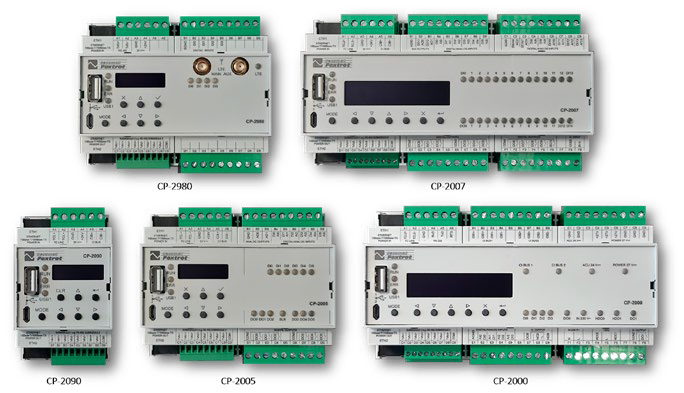
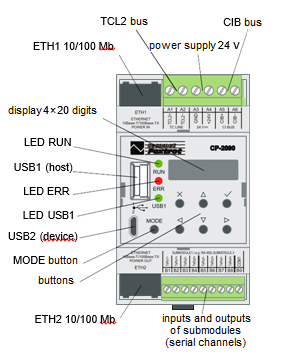
Fig. 1 Layout of elements on the smallest PLC from the new Tecomat Foxtrot 2 series.
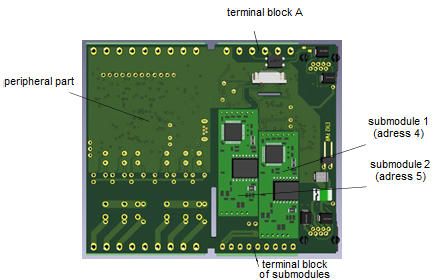
Fig. New submodules with a serial port interface (see lighter green) are applied by sliding them into the motherboard from below.
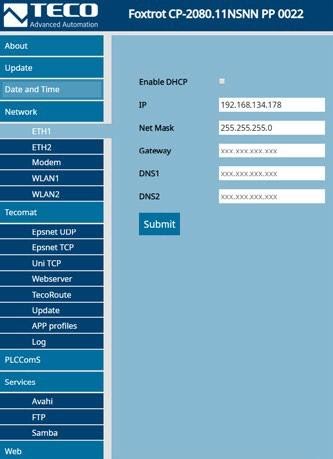
Fig. For informed specialists, there is a "tasting" of the expanded menu of system websites, from which it is possible to estimate the breadth of functions supported by the new Foxtrot.
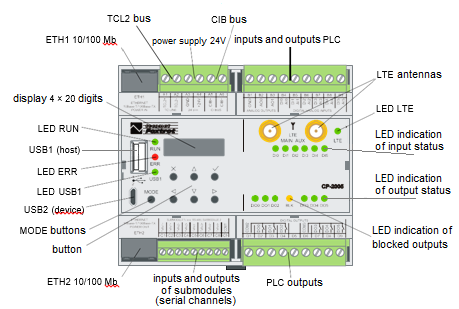
Fig. Layout of elements on PLC with equipped LTE modem.
 English
English